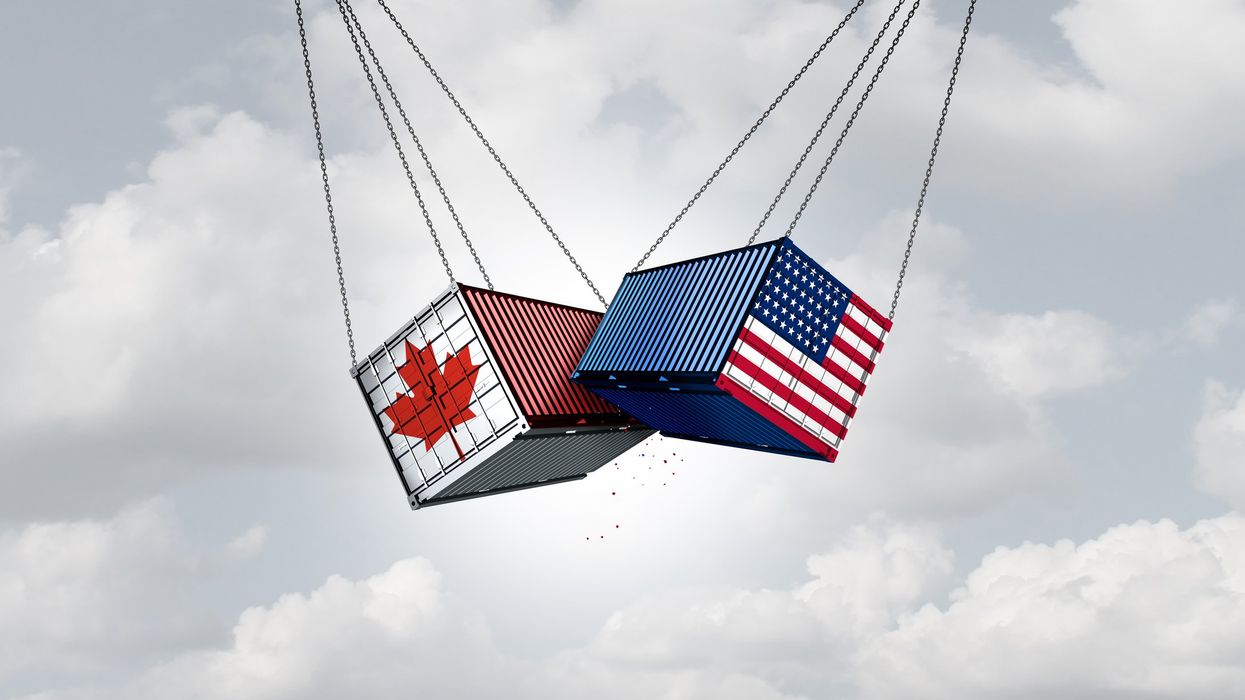The Fulcrum strives to approach news stories with an open mind and skepticism, striving to present our readers with a broad spectrum of viewpoints through diligent research and critical thinking. As best we can, remove personal bias from our reporting and seek a variety of perspectives in both our news gathering and selection of opinion pieces. However, before our readers can analyze varying viewpoints, they must have the facts.
Here’s the latest on Canadian tariffs effective 2:00 PM April 3, 2025
Auto Tariffs Retaliation: Canadian Prime Minister Mark Carney announced that Canada will match the U.S.'s 25% tariffs on auto imports. This move comes as a response to U.S. President Donald Trump's tariffs, which have already impacted the Canadian auto industry.
Senate Pushback: In the U.S., a bipartisan group of senators is working to revoke Trump's tariffs on Canadian goods. The resolution has gained support from both Democrats and some Republicans, highlighting concerns about the economic impact of these tariffs.
Broader Trade Tensions: Trump has introduced a 25% tariff on foreign-made automobiles and a baseline 10% tariff on all imports, with Canada facing specific measures. These actions have sparked calls for boycotts of American goods in Canada and other countries
Update to 'Just the Facts: Canadian Tariffs' published on March 13, 2025
What are the Tariffs imposed by the U.S. against Canada so far in 2025 and by Canada against the U.S. so far in 2025?
In 2025, the trade relationship between the U.S. and Canada has been marked by escalating tariffs:
U.S. Tariffs on Canada:
- The U.S. imposed 25% tariffs on Canadian steel and aluminum imports. The Trump administration threatened to increase the tariff to 50% but this has not yet been implemented.
- Recently, Ontario, Canada, imposed a 25% tariff on electricity exported to the United States. This measure was part of a broader trade dispute with the U.S., particularly in response to tariffs on Canadian steel and aluminum. However, after discussions between Ontario Premier Doug Ford and U.S. Secretary of Commerce Howard Lutnick, the tariff was suspended.
Canada's Tariffs on the U.S. in response to the steel and aluminum tariffs:
- Canada has retaliated against the U.S. 25% tariff on steel and aluminum by imposing its own tariffs. Canada introduced a 25% tariff on $30 billion worth of U.S. goods, including orange juice, peanut butter, wine, spirits, beer, coffee, appliances, and more. Canada has plans to expand these tariffs to cover an additional $125 billion worth of products. This move was part of a broader trade dispute between the two countries.
This trade tension has already disrupted supply chains and raised concerns about economic impacts on both sides.
If the steel and aluminum tariffs stay in place, how much will that add to the cost of a car manufactured in the U.S.?
The steel and aluminum tariffs in place could significantly impact the cost of manufacturing cars in the U.S.:
- A 25% tariff on steel and 10% on aluminum could increase the cost of producing a typical vehicle by $1,500.
- Steel and aluminum make up over 60% of a car's weight, so these tariffs directly affect production costs.
- Smaller car manufacturers may face even greater challenges, as they have less flexibility to absorb or offset these increased costs.
This could lead to higher prices for consumers and tighter profit margins for automakers.
Will these new tariffs cost more to the United States or to Canada?
The economic impact of the tariffs between the U.S. and Canada in 2025 is significant for both nations, but the exact costs vary, depending on a variety of variables.
- Canada: The tariffs are expected to have a larger proportional impact on Canada's economy. Canadian exports to the U.S. represent roughly 20% of its GDP, and the tariffs could lead to a 2.5%-3% decline in GDP. Canadian households may face annual costs of around $1,900.
- United States: While the U.S. economy is larger and less reliant on Canadian trade, the tariffs still have notable effects. U.S. households could lose about $1,300 per year, and gasoline prices might rise by $0.30-$0.70 per gallon due to energy tariffs. Additionally, industries dependent on Canadian imports, such as manufacturing, could face disruptions.
In summary, the relative economic burden is heavier for Canada due to its greater reliance on trade with the U.S., but both countries are experiencing significant costs.
What is the dollar amount of U.S. citizen travel to Canada and Canadian travel to the United States?
In 2025, travel between the U.S. and Canada remains significant, though exact dollar amounts for this year are not readily available. However, here are some insights:
- U.S. Citizens Traveling to Canada: In 2024, U.S. residents made 23.4 million trips to Canada, an increase of 10.7% from the previous year. While the dollar amount spent isn't specified, the favorable exchange rate often makes Canada an attractive destination for American travelers.
- Canadian Citizens Traveling to the U.S.: In 2024, Canadian residents took 39 million trips to the U.S., a 4.4% increase from 2023. A 10% reduction in Canadian travel to the U.S. could result in $2.1 billion in lost spending, highlighting the economic impact of cross-border tourism.
Original 'Just the Facts' story published on March 9, 2025
A tariff is a tax imposed by the government of a country or customs territory on imports or exports of goods.
Before President Trump took office, what tariffs, if any, did Canada have on US products exported to Canada from the US?
Before Donald Trump took office, Canada had tariffs on certain U.S. products. Still, these were generally in line with World Trade Organization (WTO) agreements and the North American Free Trade Agreement (NAFTA). These tariffs were relatively low and applied to specific categories like agricultural products, dairy, and poultry, which are sectors protected under Canada's supply management system. For example, Canada imposed tariffs on U.S. dairy imports to protect its domestic dairy industry.
Before President Trump took office, did the United States impose tariffs on Canadian products imported from Canada?
Before January 1st, the United States imposed tariffs on certain Canadian products, particularly during trade disputes. For example:
- Steel and Aluminum: In 2018, the U.S. imposed a 25% tariff on Canadian steel and a 10% tariff on aluminum under Section 232 of the Trade Expansion Act, citing national security concerns.
- Softwood Lumber: The U.S. has long imposed duties on Canadian softwood lumber, with rates varying over time due to ongoing trade disputes.
- Dairy Products: While not a tariff, the U.S. restricted imports of certain Canadian dairy products under trade agreements like NAFTA.
Before President Trump took office, what tariffs did Canada impose on U.S. goods, and what percentages were there on various products exported to the US?
Before January 1st, Canada had tariffs on certain U.S. products, primarily in sectors protected under its supply management system. These included:
- Dairy Products: Tariffs ranged from 200% to 300% on items like milk, cheese, and butter to protect Canadian dairy farmers.
- Poultry and Eggs: Similar high tariffs were applied to chicken, turkey, and eggs.
- Grain Products: Some grains faced tariffs, though these were generally lower than those on dairy and poultry.
These tariffs were part of Canada's long-standing trade policies to support domestic industries.
Do US farmers need to export dairy products to make money?
Exports are crucial for the U.S. dairy industry. About one-sixth of all milk produced in the U.S. is destined for international markets, making exports a significant part of the industry's revenue. In 2024, U.S. dairy exports reached $8.2 billion, with key trading partners like Mexico and Canada accounting for over 40% of these exports.
Without access to global markets, U.S. dairy farmers would face challenges like oversupply, lower prices, and reduced profitability. International trade helps balance domestic supply and demand, ensuring farmers can sustain their operations.
Do trade agreements between Canada and the US favor Canada or the US?
Trade agreements between Canada and the United States, such as the United States-Mexico-Canada Agreement (USMCA), are designed to be mutually beneficial. Still, their impact can vary depending on the industry and perspective.
- For the U.S.: The USMCA includes provisions that benefit American farmers, particularly in gaining greater access to Canada's dairy market. It also strengthens rules of origin for automobiles, which supports U.S. manufacturing jobs.
- For Canada: Canada benefits from stable access to its largest trading partner, the U.S., which is crucial for its economy. The agreement also preserves key elements of the previous NAFTA, such as dispute resolution mechanisms, which Canada values.
Overall, the agreements aim to balance interests, but debates often arise about whether one side gains more. For example, some argue that the U.S. benefits more due to its larger economy and leverage, while others highlight Canada's ability to protect critical industries like dairy and cultural sectors.
In 2023 and 2024, was the amount the U.S. imported from Canada greater or less than what the U.S. exported to Canada…i.e., What is the level of trade imbalance?
In both 2023 and 2024, the United States imported more from Canada than it exported to Canada, resulting in a trade deficit:
- 2023: U.S. exports to Canada totaled approximately $354.4 billion, while imports from Canada were about $418.6 billion, leading to a trade deficit of $64.3 billion.
- 2024: U.S. exports to Canada were around $349.4 billion, and imports from Canada reached $412.7 billion, resulting in a trade deficit of $63.3 billion.
This trade imbalance is largely due to the U.S. importing significant energy products from Canada, such as crude oil and natural gas.
Is the size of the US trade imbalance with Canada bad for the US economy?
The trade imbalance between the U.S. and Canada is a nuanced issue. While Canada often exports more to the U.S. than it imports, this isn't necessarily "bad" for the U.S. economy. Here's why:
- Integrated Supply Chains: The U.S. and Canada have deeply interconnected economies. Many Canadian exports, like auto parts and energy products, are essential inputs for American industries. This integration supports jobs and economic activity in both countries.
- Balanced Trade in Services: While there may be a deficit in goods, the U.S. often runs a surplus in services trade with Canada, which helps offset the imbalance.
- Economic Growth: Trade deficits aren't inherently harmful. They can reflect strong consumer demand and economic growth in the U.S. as Americans buy more goods, including those from Canada.
However, some argue that persistent trade deficits could indicate lost opportunities for domestic production or jobs. However, in Canada, the relationship is more about mutual benefit than competition.



















